Sun 23 Apr 2023
A Book! Movie!! Review by Tony Baer: SHERWOOD KING – If I Die Before I Wake // The Lady from Shanghai (1947).
Posted by Steve under Mystery movies , Reviews[7] Comments
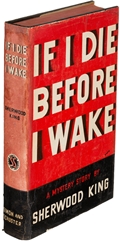
SHERWOOD KING – If I Die Before I Wake. Simon & Schuster, hardcover, 1938. Mystery Novel Of The Month [no number], digest-sized paperback, 1940. Ace Double D-9, paperback, 1953. Curtis, paperback, 1965. Penguin Classic, softcover, 2010. Film: Columbia, 1947, as The Lady from Shanghai. (Rita Hayworth, Orson Welles, who also directed).
Another from James Sandoe’s hardboiled checklist , this novel formed the basis of the Orson Welles film The Lady from Shanghai, which is one of my favorite noirs.
The experience of reading the novel was similar to reading In a Lonely Place after seeing Nicholas Ray’s great film. That is to say, there’s a strange cognitive dissonance. The film is so vividly done that it stays with you. And now you read a story with the same characters in the same time and place, and they act completely differently, resulting in a starkly different experience. It’s weird. Rifted from one universe into another like a car crash jettisoning you out the window, shards shattering, thrusting you through the looking glass.
It makes it hard for me to judge the book without a bit of resentment. And the resentment is utterly unfair because the book came first. But the images of the film are so entrenched that I simply cannot accept the story presented by the book.
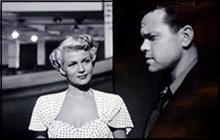
First of all, the first person protagonist is named Laurence Planter — not Michael O’Hara. Though in both he’s a sailor. In the film Orson Welles gives us a robustly distracting Irish brogue. Planter is no more Irish than Welles. So the choice to turn Planter to O’Hara is pretty odd. Welles must have just wanted an opportunity to show his range or something. There’s very little background so his nationality is irrelevant to the narrative.
Planter gets sucked into the lavishly unseemly seaminess of Mr. and Mrs. Bannister. In the film he enters rescuing Mrs. Bannister from Central Park muggers. In the book, he’s hired as Chauffeur on the spot when Mr. Bannister spies him swimming up to their Long Island shore. Marvelous tanned physique in tow.
Mr. Bannister’s stuttered gait (in both film and book) is horribly maimed lame by a wartime missile. This causes Bannister to be forever angry at his loss of youth, and at those that have it and don’t appreciate it. They die before they wake.
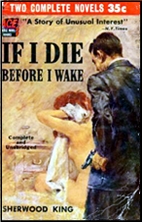
Bannister leverages his disability into guilt subjecting his wife Elsa into a life of sad subjection. Without objection. And yet Bannister wants to tempt his wife and to spy upon her, looking and luring her with opportunity for alienated affections, the better to guilt her with and rail upon her for her rancid heart. Planter/O’Hara was drawn up by central casting as the perfect lure. Handsome, winsome, and nitwit.
Bannister is a great criminal defense attorney, as is his law partner Grisby. Grisby hires our fair sailor for a dirty deed. Grisby wants to disappear. He wants our sailor to pretend, in plain sight, to murder him and pretend to throw his body into the sea. Corpus delicti — without the body you can prove no crime. Meanwhile Grisby will escape safe to sea, via speedboat, presumed dead — while our sailor cannot be held to blame. And five grand the richer for really doing nothing wrong.
But Grisby isn’t just using his fake death to escape the world’s travails. He’s using it as perfect cover for the perfect crime. Once he’s ‘dead’, he will murder Bannister. There’s partnership insurance for $100 grand. And with both he and Bannister dead, the suddenly single Mrs. Bannister will join Grisby in the south seas, $100,000 the richer.
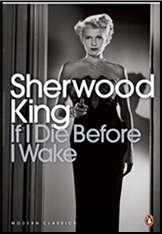
I don’t remember from the movie this part at all, frankly (it has been a while). But I do recall a confused sense of fuzziness at why Grisby wanted to fake his own death and murder Bannister.
In the book the murder plan makes perfect sense when it becomes clear that Grisby is in love with Elsa Bannister — he has every reason in the world to want to kill her husband and take his place. But in the film Grisby comes off quite pervy and queer and displays not the slightest interest in the breathtaking Rita Hayworth (Elsa Bannister). He seems more attracted to Orson Welles’s sailor. As a result the Grisby’s motive has always confused me til now.
Another note about Rita Hayworth, Elsa Bannister, and the adaptation. Rita Hayworth was famous for her flaming red hair. As was Elsa Bannister. Yet in the film Welles made Hayworth dye her hair blonde. Another odd dissonance. And she’s never been to Shanghai!
In any case, in both film and book it is Grisby’s body found slain, our innocent sailor bound to blame.
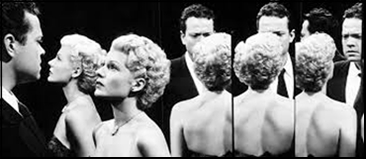
I won’t get into the ending — but while the result is the same, the manner of getting there is completely different. There’s no thrilling escape from custody, there’s no scene in the abandoned funhouse, no shooting shattered funhouse mirrors, shards splayed in bodies lain.
And so frankly, after the thrilling film, the book’s ending is relatively quiet and staid. Again — it’s the same result. But the joy is in the ride and the ride is not nearly so wild and dipsy doodle and crashing as the film.
So read it if you want. It’s good but not great. And not nearly so great as the film. Which, sadly, is diminished rather than enhanced with the reading of the book. It’s a book whose esteem would be greater had it never been adapted by a greater genius than the author of the book.
April 23rd, 2023 at 10:01 pm
Luckily I read the book before seeing the film so I enjoyed both. The Welles film is a curious thing, beautiful to look at, but not really making much sense anyway but visually.
The book on the other hand is intelligent and sets up all the dominoes to fall in the proper order.
I love the movie, but I would still like to see the book filmed.
April 24th, 2023 at 12:22 am
David,
The movie made sense to me, and as a consequence, I don’t understand the problem. If it’s Grisby, I just have accepted that, as I accept Rita is playing a former prostitute. This is quite clear and is covered by her sly reference to Shanghai and her behavior. Due to studio interference, we have to bring our sensibility to it, no problem. I know some people do not like Orson’s performance. I am not one of them. For me, it is Welles at his most attractive.
April 24th, 2023 at 12:57 am
What none of us has mentioned is another great performance by Everett Sloane.
As for Welles, I can see why his performance bother some, not me, but he is at the most youthful and healthy that I think I ever saw him in a movie and engaging in a different role.
April 24th, 2023 at 7:37 am
Tony,
Thanks for the review. In your last paragraph you state the book would be in higher esteem if the movie were never made. My opinion is if the movie were never made, it would just be another forgotten
book by another forgotten author. As far as the movie, I think it’s one of Welles best! I don’t understand why Welles made the character have an Irish brogue, but Man! what a film!
April 24th, 2023 at 8:41 am
Paul,
I’m afraid you’re right. No one would likely remember the book at all but for the amazing filmwork by Welles. I suppose I was speaking only personally–I would likely hold the book in higher esteem had I not seen the film. The book was a bit of a disapppointment to me. Not really due to any fault of the book–but more because it is one of the few instances where the source novel pales in comparison with the film version. And because of the conflict between the version of the story in the film versus the book the reader/viewer is forced to make a choice. They really can’t co-exist. And if forced to pick: I choose the film.
April 26th, 2023 at 12:23 am
I’m having a twilight zone moment. After you posted this review [but before I read it] I started watching the YouTube version of the Lady from Shanghai. I also started reading the novel by King, and I’m currently about 1/3 of the way through. So far, I find the novel plodding, compared to the film. I’m going through Welles phase at the moment, and I’ve been reading a lot about the film. So many scenes are reminiscent of both A touch of Evil, and Othello. One point about Lady from Shanghai, is that Welles once again, lost editing control over the film. His final cut of the film had it at 155 minutes. Over an hour of that was cut, to produce the current version, which is so highly regarded.
April 26th, 2023 at 11:49 am
The story goes, that Welles was trying to raise money for his road show stage production of Around the World in Eighty Days, and was on a pay phone trying to sell Harry Cohen that he has a great book to adapt to a film and he needs fiancing for it. Suppoesedly, Welles just scans some paperback books from a near by rack and selected this crime novel after a quick look at the blurp on the back cover.
Now the two sad things here are that Welles’ original version of the film is lost, and why he didn’t mount a road show stage version of War Of The Worlds instead of the Verne novel?